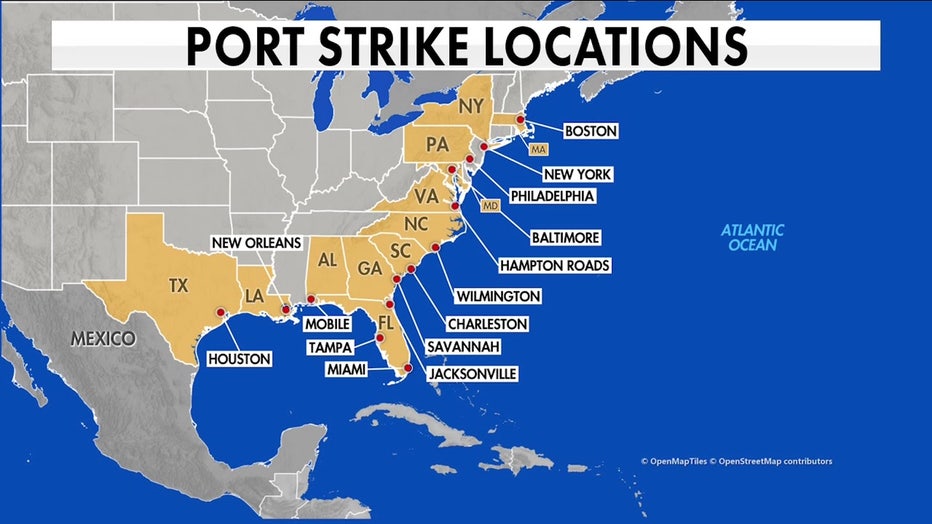Port strikes: Philadelphia dockworkers join thousands in standoffs along East, Gulf coasts

Dockworkers strike for 1st time in nearly 50 years
For the first time in nearly 50 years, the International Longshoremen?s Association dockworkers are striking. FOX 29's Jeff Cole has the climate at Philly?s normally bustling Packer Marine Terminal which is now slowing to a trickle.
PHILADELPHIA - A strike that could bring higher prices and shortages of goods has begun at ports up and down the East Coast, and along the Gulf Coast.
Workers with the International Longshoremen’s Association walked off the job at midnight Tuesday when their wages and automation contract expired.
The strike impacts more than 45,000 workers at three dozen U.S. ports from Maine to Texas, including Philadelphia, Wilmington and Baltimore.
"The Ocean Carriers represented by the United States Maritime Alliance want to enjoy rich billion-dollar profits that they are making in 2024, while they offer ILA Longshore Workers an unacceptable wage package that we reject," the union said in a statement.
Operations could be seized at the Port of Philadelphia and Port of Wilmington, and experts say the strike could reignite inflation and cause shortages of goods if it goes on for more than a few weeks.

FOX 29's Hank Flynn was live as workers gathered at the Port of Philadelphia in the union's first strike since 1977.
Philaport, who manages the Philadelphia Terminals, says they are aware of the potential strike but are not directly involved:
"The United States Maritime Alliance and the ILA have been negotiating since late May of this year with little movement. The major issues at hand are wage increases, automation, and technology," they said in a statement.
"You have foreign countries coming over here dictating to us what they’re going to do. We’re taxpayers we’re going to take these jobs- -we’re to stay and do these jobs," said Daniel Gallagher/President, I.L.A. Local 1242.
A long strike could hammer regional economies reliant on the fruit, frozen meat, steel, and paper products flowing from hulking container ships moving along the Delaware.
The U.S. Maritime Alliance, a coalition of port operators and shipping companies, writes it’s offered to "increase wages by 50 percent", and "retain the current language around automation and semi-automation", but the union walked.
"Our biggest fight is automation. You can have as much of a raise as you want but if you cut the workforce in half the wage really doesn’t matter anymore," said Dylan Snively, IInternational Longshoremen’s Association.
Strikers gathered with signs at the Packer and Tioga Terminals on Tuesday hoping their first-in-decades job action will save their work.
Here is what to know about the labor dispute and effects of the strike:
Dockworker labor dispute
For the strike to end, the ILA, which represents 45,000 members at East and Gulf coast ports, needs to make a deal with the United States Maritime Alliance (USMX), which represents the ports.
Much of the labor dispute involves the addition of new technologies to U.S. ports that the union says could ultimately cause job losses.
The union is demanding a total ban on the automation of cranes, gates and moving containers in the loading and unloading of freight, along with significantly higher wages.
West Coast dockworkers belong to a different union and aren't involved in the strike.
What does the port strike affect?

Here's how the dockworkers' strike will impact supply chains
Now that thousands of port workers have gone on strike, FOX 29's Greg Payne has the scoop on how the strike could hurt businesses and consumers amid supply chain disruptions.
The port strike is affecting operations at 36 U.S. docks stretching from Maine to Texas, which means the number of goods coming in and out of the country will begin lessening by the day.
Just how long the strike lasts depends on how severely the supply chain could be affected.
If drawn out, the strike would force businesses to pay shippers for delays and cause some goods to arrive late for peak holiday shopping season — potentially impacting delivery of anything from toys or artificial Christmas trees, to cars, coffee and vegetables.
Americans could also face higher prices as retailers feel the supply squeeze.
"Everyone from the shipping lines to trade groups and maritime industry analysts also warns of widespread ramifications in the global supply chain," reported The Maritime Executive, a maritime industry magazine and newsletter. "Sea-Intelligence has estimated that for each day of a strike, it would take four to six days to clear the backlog. They wrote that even a two-week strike could have ramifications into 2025."
FOX Business reported that JP Morgan issued an estimate that a strike would cost the U.S. economy as much as $5 billion a day.
White House intervention
All eyes are on what, if any, action the Biden administration might take — particularly just weeks ahead of a tight presidential election.
The president has the power to order an 80-day cooling-off period, suspending the strike, under the 1947 Taft-Hartley Act. But Biden has indicated he’s not interested in intervening.
"Because it’s collective bargaining, I don’t believe in Taft-Hartley," he said during an exchange with reporters on S

